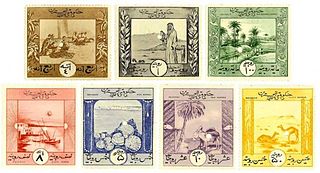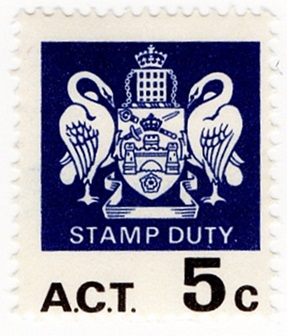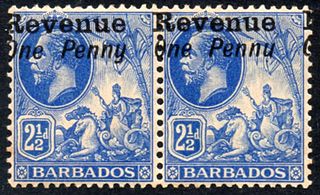
A revenue stamp, tax stamp, duty stamp or fiscal stamp is a (usually) adhesive label used to designate collected taxes or fees on documents, tobacco, alcoholic drinks, drugs and medicines, playing cards, hunting licenses, firearm registration, and many other things. Typically, businesses purchase the stamps from the government, and attach them to taxed items as part of putting the items on sale, or in the case of documents, as part of filling out the form.

Postage stamps have been used in Cameroon or Cameroun since the nineteenth century.

This is a survey of the postage stamps and postal history of Malawi.

The first revenue stamps of Bahrain were issued in 1924. Before then Indian revenue stamps were used on documents. Revenue stamps have been used for Land Registry documents, drivers permits and the Dhow Registry.

Bolivia has issued revenue stamps since 1867.

The Australian Capital Territory issued revenue stamps from 1966 to 1983 for stamp duty. The first issue had the coat of arms of the territory and had ten values ranging from 5c to $10 in various colours. The second issue was a set of three similar to the first but without watermark. There might have been a conveyance issue in 1990 but no examples have been recorded.

Zanzibar issued revenue stamps from when it was a British protectorate in 1892, to after when it became part of Tanzania in 1993.

The Australian territory of Northern Territory, known as North Australia between 1929 and 1935, issued revenue stamps from 1917 to 2006.

The island of Antigua issued revenue stamps from 1870 to 1876. The island's short life as a revenue stamp-issuing country was mainly due to the use of postage stamps for most fiscal purposes from 1862 to 1870, and again from 1890 onwards. Therefore, the only revenues issued are more commonly found mint than used. The first set was issued in 1870 and it consisted of eleven values from 1d to 10s, and four of these values were reprinted in 1876 with a different watermark. This makes a total of just fifteen revenues, with most sought after one being the 10s stamp of 1870.

The British colony of Zululand issued revenue stamps in 1888. The only set consisted of seven values of 1d, 1s, 5s, 9s, £1, £5 and £20 of Natal revenues overprinted ZULULAND in a similar overprint to that used for postage stamps. The 1d later became valid for postal use as well. All the higher values now command high prices and are quite rare. In addition to this issue, the same Natal £5 is known with a different overprint in violet, but it is not known if this was a legitimate issue or not.

The Leased Territory of Weihaiwei used revenue stamps from 1921 to 1930. The only issue consisted of British King George V keytypes overprinted WEIHAIWEI and a value in cents or dollars. Five values were issued: 1c, 2c, 10c, 50c and $1. The 10c on 3d also exists with additional handstamped surcharges of 1c and 2c. These revenues were withdrawn in 1930 when the leased territory was handed back to China. All of Weihaiwei's revenues are scarce or rare and are highly sought after by collectors.

The British colony of Gibraltar issued revenue stamps from 1884 to 1976.
British Honduras issued revenue stamps in 1899. The only issue consisted of contemporary postage stamps overprinted "REVENUE". Four values exist - 5c, 10c, 25c and 50c on 1s, and there are two different sizes of the overprint - 11mm and 12mm long. Additionally there are a number of varieties in the overpint which are very collectible, such as "BEVENUE", "REVENU " and "REVE UE". Despite being intended for fiscal use, they were also valid for postal use.

The British colony of Bermuda issued revenue stamps from 1936 to 1984.

Revenue stamps of the British Solomon Islands, now known as the Solomon Islands, were first issued in around 1926 when the islands were a British protectorate. The only revenue stamps issued by the islands were British embossed adhesives overprinted BRITISH SOLOMON ISLANDS in three lines. Five stamps are recorded: two versions of a 1s value issued in 1926 and 1931, and £5, £10 and £50 values issued in 1964. All are rare and command high prices.

The island of Barbados first issued revenue stamps in 1916. There were various types of fiscal stamps for different taxes.
British Somaliland, a British protectorate in present-day Somaliland, issued adhesive revenue or fiscal stamps between 1900 and 1904. All Somaliland fiscals were revenue stamps of India overprinted BRITISH SOMALILAND.
Revenue stamps of Guernsey refer to the various revenue or fiscal stamps, whether adhesive or directly embossed, which were issued by the States of Guernsey for use on the island of Guernsey, a British Crown dependency. There were general-duty revenues, along with issues for Entertainments Tax, Sales Tax, Income Tax and Insurance.
Revenue stamps of Jersey refer to the various adhesive revenue or fiscal stamps issued by the States of Jersey for use on the island of Jersey, a British Crown dependency. The island has issued general-duty revenues, along with issues for Justice, Property Guarantee Fund and Social Assurance.
Revenue stamps of Guyana refer to the various revenue or fiscal stamps, whether adhesive, directly embossed or otherwise, which have been issued by Guyana since its independence in 1966. Prior to independence, the country was known as British Guiana, and it had issued its own revenue stamps since the 19th century. Guyana used dual-purpose postage and revenue stamps until 1977, and it issued revenue-only stamps between 1975 and the 2000s. The country has also issued National Insurance stamps, labels for airport departure tax and excise stamps for cigarettes and alcohol.















